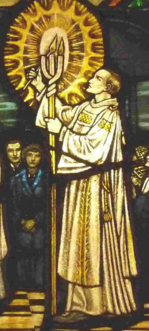
A triple candlestick, also known as reed, tricereo, arundo, triangulum, or lumen Christi, was a liturgical object prescribed until 1955 in the Roman Rite Easter Vigil service, held on Holy Saturday morning.[1][2]
In the Easter Vigil service, the deacon or priest lights each of its three candles in succession, chanting each time in ascending tones, "Lumen Christi" ("The light of Christ"), to which the choir answers "Deo gratias" ("Thanks be to God"). From one of the candles on the triple candlestick, the Paschal candle is afterwards lit during the chanting of the Exsultet.[3][4]
In 1955 the triple candlestick was abolished in the liturgical reforms of Pope Pius XII. Since then, the Paschal candle is lit directly from the Paschal fire at the beginning of the Easter Vigil mass.
References[edit]
- ^ "triple candlestick". Oxford Reference. Retrieved 2022-09-05.
- ^ "CATHOLIC ENCYCLOPEDIA: Triple-Candlestick". www.newadvent.org. Retrieved 2022-09-05.
- ^ Manlio Sodi, Achille Maria Triacca (editors), Missale Romanum: Editio Princeps (1570) (Libreria Editrice Vaticana 1988 ISBN 978-88-209-2547-5), pp. 254–262
- ^ Missale Romanum (Marietti, 1921), pp. 177–183
Further reading[edit]
- Tribe, Shawn (3 April 2018). "On the Reed or Tricereo (The Triple Candle)". Liturgical Arts Journal. Retrieved 2022-09-06.
Well, that’s interesting to know that Psilotum nudum are known as whisk ferns. Psilotum nudum is the commoner species of the two. While the P. flaccidum is a rare species and is found in the tropical islands. Both the species are usually epiphytic in habit and grow upon tree ferns. These species may also be terrestrial and grow in humus or in the crevices of the rocks.
View the detailed Guide of Psilotum nudum: Detailed Study Of Psilotum Nudum (Whisk Fern), Classification, Anatomy, Reproduction